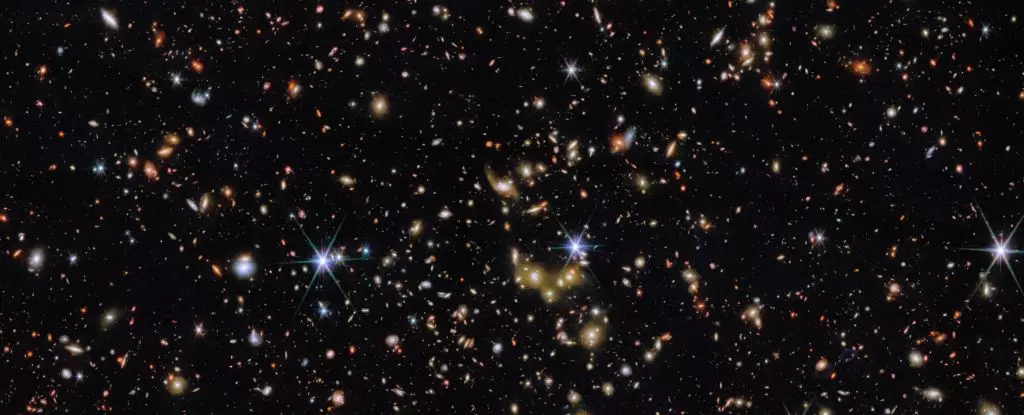The recent release of a spectacular image from the James Webb Space Telescope (JWST) offers an eye-opening voyage back in time, showcasing a minuscule patch of sky teeming with celestial activity. Stretching back nearly 12 billion light-years, this astonishing view captures the breathtaking vastness of our universe and the myriad galaxies that inhabit it, all within a region less than one-fifth the width of the full Moon. Observing this image elicits feelings of wonder and humility—reminding us of our small place in the cosmos and the grandeur that exists beyond our terrestrial confines.
While the untrained eye may initially perceive the scene as a blend of familiar twinkling lights, a closer inspection reveals a much more complex reality. The majority of these luminous points are not mere stars, but elaborate galaxies, each harboring billions of stars within their swirling form. The distinction becomes evident through the defining diffraction spikes unique to JWST’s imaging technology; bright stars appear with these characteristic lines, while the dispersed light of galaxies does not. This highlights the profound difference between stellar bodies and vast galactic structures, illuminating our understanding of cosmic evolution.
Understanding Galactic Clusters
Among the most intriguing aspects of this latest image is the focus on a group of galaxies that radiate a golden hue, situated just below the image’s center. This particular cluster represents light that has traveled around 6.5 billion years to reach Earth—almost half the age of the universe itself. The implications of such immense timescales are staggering. This light carries with it a history that predates much of what we know about ordinary cosmic phenomena, painting a picture of a constantly evolving universe shaped by forces far beyond our comprehension.
These observations are integral to the COSMOS-Web survey, a systematic endeavor aimed at mapping and cataloging the relationships between different groups of galaxies. Far from randomly scattered objects, the galaxies form intricate clusters connected by a cosmic web of dark matter and hydrogen. Scientists are only beginning to grasp the depth of this structure, and the JWST’s capacity to reveal these ties is a monumental leap forward in astrophysical research.
The Cosmic Web: More Than Meets the Eye
The image doesn’t stop at showcasing the thundering magnificence of distant galaxies; it also serves as a portal to understanding the underlying architecture of the universe. A collaboration led by astrophysicist Greta Toni has identified an astonishing 1,678 groups of galaxies cataloged from this data. This staggering number emphasizes a crucial point: the abundance of galactic structures is not a rarity but the expected norm throughout the universe.
What makes this revelation even more remarkable is the scale at which it has been observed. This patch of sky, measuring a mere 6.44 by 6.44 arcminutes—a small fragment of the celestial dome—holds a density of galaxies that promises to exist in countless other unspecified patches of the sky. With each exploration, one might uncover thousands of galaxies in spaces smaller than a fingertip.
Revolutionizing Our Cosmic Perspective
The revelations brought forth by JWST’s deep field images require us to reevaluate our cosmic perspective. As we gaze into the depths of space, we are not just admiring beauty; we also unravel the fundamentals of the universe. Each image serves as a stepping stone to answering age-old questions about the fundamental nature of matter, the synthesis of elements, and the cosmic journey that has unfolded since the dawn of time.
These celestial photographs compel humanity to foster a deeper connection with our place in the universe. They evoke a sense of pride and urgency; as we decipher the mysteries of the cosmos, we are reminded of the infinite possibilities that lie ahead in our pursuit of knowledge. Scientific endeavors, such as those conducted with JWST, are more than just studies; they are a call to explore the unknown boundaries of existence. Each pixel of data we uncover signals an unequivocal truth: the universe is not only vast and beautiful but fundamentally interconnected, echoing a harmony that extends far beyond our human understanding.


Leave a Reply